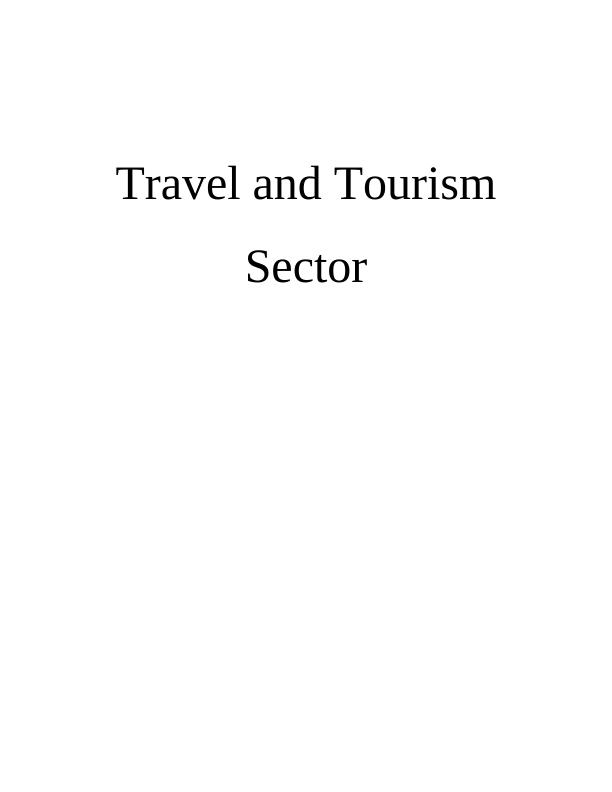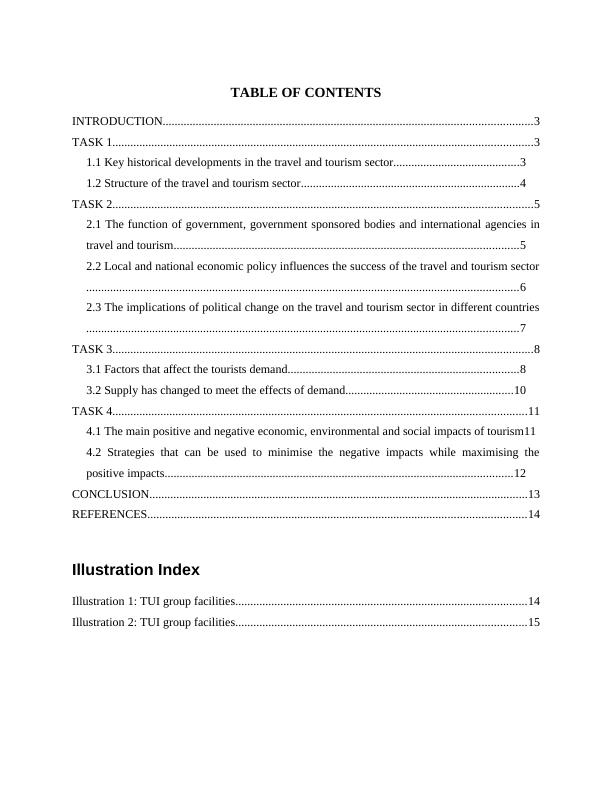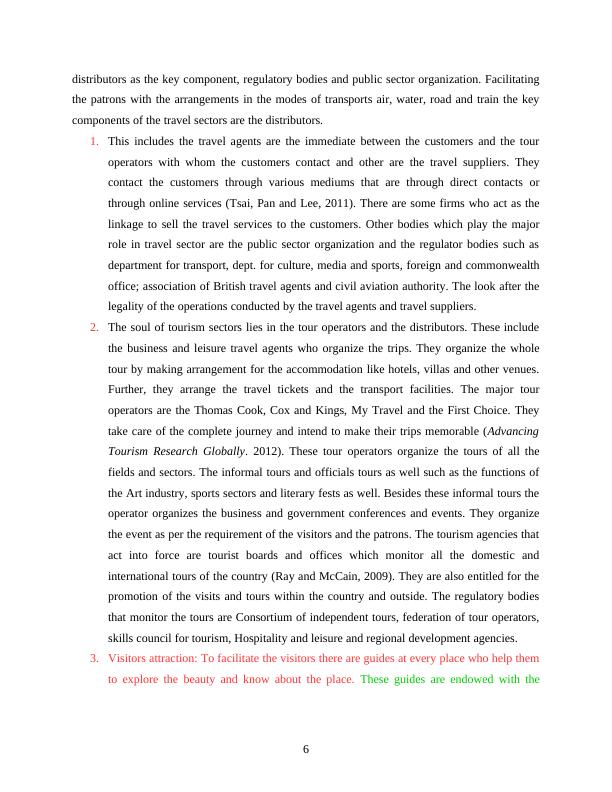The Travel and Tourism Sector
21 Pages7264 Words161 Views
Added on 2019-12-28
About This Document
Travel and Tourism Sector TABLE OF CONTENTS INTRODUCTION 3 TASK 13 1.1 Key historical developments in the travel and tourism sector 3 1.2 Structure of the travel and tourism sector 4 TASK 25 2.1 The function ofgovernment,governmentsponsored bodiesand international agencies in travel and tourism 5 2.2 Local and national economic policy influences the success of the travel and tourism sector 6 2.3 The implications of political change on the travel and tourism sector in different countries 7 TASK 38 3.1 Factors that affect the tourists demand 8 3.2
The Travel and Tourism Sector
Added on 2019-12-28
ShareRelated Documents
Travel and TourismSector

TABLE OF CONTENTSINTRODUCTION...........................................................................................................................3TASK 1............................................................................................................................................31.1 Key historical developments in the travel and tourism sector..........................................31.2 Structure of the travel and tourism sector.........................................................................4TASK 2............................................................................................................................................52.1 The function of government, government sponsored bodies and international agencies intravel and tourism...................................................................................................................52.2 Local and national economic policy influences the success of the travel and tourism sector................................................................................................................................................62.3 The implications of political change on the travel and tourism sector in different countries................................................................................................................................................7TASK 3............................................................................................................................................83.1 Factors that affect the tourists demand.............................................................................83.2 Supply has changed to meet the effects of demand........................................................10TASK 4..........................................................................................................................................114.1 The main positive and negative economic, environmental and social impacts of tourism114.2 Strategies that can be used to minimise the negative impacts while maximising thepositive impacts....................................................................................................................12CONCLUSION..............................................................................................................................13REFERENCES..............................................................................................................................14Illustration IndexIllustration 1: TUI group facilities.................................................................................................14Illustration 2: TUI group facilities.................................................................................................15

INTRODUCTIONTravel and tourism is the largest service industry in terms of revenue generation andforeign exchange earnings. Tourism has the huge growth market. It is driven by the humantendency to move from one place to another in urge of recreational desires, knowledge seeking,business purposes, adventure and entertainment. Consequently, it brings cross-synergisticbenefits to the economy. London has the long-standing history of tourism. People have beencoming here to explore the architectural assets (Barrett, 2012). Castles, museums, art galleries,stately homes, royal palaces, garden and theme parks, zoos, globally acclaimed universities havebeen capturing the eyes of visitors around the globe. This report outlines the various aspects oftourism in London. It states the historical development and the structure of travel and tourism inLondon, the impact of Government and international agencies, economic policies and thepolitical change in the country. It focuses on the factors affecting tourism demand and changes inthe supplies to meet it. Further it evaluates the positive and negative impacts of tourism and thestrategies to rationalize their impacts. TASK 11.1 Key historical developments in the travel and tourism sectorTravel and tourism in London is flourishing from long history. At present travel andtourism sector in the country holds the prime position in market share. Having the world'sprestigious destination, London is the world's leading tourist place with around 15.3 millionvisitors a year. The country has been capturing the interest of the tourists from all over the worldwith the scenic and attractive destinations, long-standing history of accommodating andentertaining tourists; thematic and featured tours and the business trips (harrison, 2006). Thenotable attractions of London are The London Eye, Ferris Wheel, London Aquarium, Big Ben,and many more.The inception of the industry dates back to the primitive era when movement of peoplefrom one place to the other was limited to the visits at holy places that is pilgrimages.These tours were undertaken for religious purposes rather than for enjoyment and fun.These trips play the vital role in realizing the importance of preserving the relics, visualart and culture and the architectural assets.3

With the passage of time these informal trips gradually were replaced by the formal toursorganized by the sponsors. First such tour was the Grand Tour that started from 1660 andflourished until 1840's. It was the traditional trip undertaken by the elite families andgroups. These were sponsored by the financial group. Till then many financial institutionsand banks came to the focus areas of the economy (Bluementritt, 2006). Predominantlythey were sources of the finance. These tour were meant to entertain and educate theBritish nobility about the cultural legacy and Renaissance. It used to last long frommonths to years. The transition in the travel and tourism in London took place after theindustrial revolution. The fast pace development of the industries brought lucrativeresults in increasing the income of the workers and the owners which initiated their willto travel more for pleasure.In 1936,Billy Butlin opens his first holiday camp in Skegnessthat revulionized thejourneys (Uriely, 2009).Further, the improved transport system made the travel easier. In the mid 19th century, thetravel companies Cox and Kings and the Thomas cook revolutionized the mass tourism.They started the era of organizing the package tour on large scale (Gray, Matear andMatheson, 2000). Initially it was organized for the families of armed forces and later on ithas broadened it horizon to the public.In 1969, The development of tourism act introduces. That mentions certain protection forconsumers and some rules and regulations are laid in it.With advent of technology, evolution of travel and travel and tourism sector took place inmany steps. Technological advancement saves time and made the journey more easy andcomfortable.Currently London is capturing the attention of wide stream of people around the Worlddue to variety of options for the patrons. Every year London hosts many events such asArt exhibitions, special events such as Chanukah, New year's parade and many more(Scheyvens, 2002).This prestigious destination is well acquainted with the accommodation facilities,convenience for the travellers, and the agency to provide the travel related information.Future Possibilities: With the increasing number of visitor every year, Travel and tourismindustry is blooming in London. The area of coverage of the industry is widened now.4

With the following factors the growth in the tourism and travel sector in London can befacilitated:1.Technology: London is the hub of the advent of technology. The improvement intransport and communication can impart significant impact on the enhancement oftourism. Technological advancements cater immense scope for development. Such as ininputing and accessing the data of tourists through the use of advanced databasemanagement and better accommodation facilities.2.Infrastructure: The contemporary infrastructure of London is the locus of attraction.Further improvement in the rail and the accommodation will attract more visitors. Withthe combination of ancient and contemporary infrastructure London attracts the widestream of visitors.3.Social condition: The centre of people with diversity of culture capture the big attention.The increased disposable income of the people has initiated the travel and tourism inLondon.4.Money: Facilities are provided to the travellers in regard with the exchange of currency.The money used here is the British pounds (Muhanna, 2006). By making the currencyfacities easier the tourism can be promoted. Obligations and delays impact the tourism inthe considerable way. Hence, with smooth functioning the journey can be made withmore ease.1.2 Structure of the travel and tourism sectorTravel and tourism sector is one of the largest industry of London with the significantshare in the market. The sector is largely fragmented with certain division.Travel sector of London caters to the activities related the recreation, leisure and businessand official trips through all modes of transport.Tourism sector is solely confined to the leisure and pleasure trips. It includes the holidaytrips, featured and thematic tours, destination holiday. Apart from general patrons itorganizes the trips for the sports-person and other industries. Both the sectors affect theeconomy considerably. It has emerged as the fastest growing sectors contributing toaround 9% of GDP (Crick and Spencer, 2011). Both the sectors are divided into many fragments with some congruent parts among them.Few departments are involved in both. Travel industry of London comprises the transport and5

distributors as the key component, regulatory bodies and public sector organization. Facilitatingthe patrons with the arrangements in the modes of transports air, water, road and train the keycomponents of the travel sectors are the distributors.1.This includes the travel agents are the immediate between the customers and the touroperators with whom the customers contact and other are the travel suppliers. Theycontact the customers through various mediums that are through direct contacts orthrough online services (Tsai, Pan and Lee, 2011). There are some firms who act as thelinkage to sell the travel services to the customers. Other bodies which play the majorrole in travel sector are the public sector organization and the regulator bodies such asdepartment for transport, dept. for culture, media and sports, foreign and commonwealthoffice; association of British travel agents and civil aviation authority. The look after thelegality of the operations conducted by the travel agents and travel suppliers.2.The soul of tourism sectors lies in the tour operators and the distributors. These includethe business and leisure travel agents who organize the trips. They organize the wholetour by making arrangement for the accommodation like hotels, villas and other venues.Further, they arrange the travel tickets and the transport facilities. The major touroperators are the Thomas Cook, Cox and Kings, My Travel and the First Choice. Theytake care of the complete journey and intend to make their trips memorable (AdvancingTourism Research Globally. 2012). These tour operators organize the tours of all thefields and sectors. The informal tours and officials tours as well such as the functions ofthe Art industry, sports sectors and literary fests as well. Besides these informal tours theoperator organizes the business and government conferences and events. They organizethe event as per the requirement of the visitors and the patrons. The tourism agencies thatact into force are tourist boards and offices which monitor all the domestic andinternational tours of the country (Ray and McCain, 2009). They are also entitled for thepromotion of the visits and tours within the country and outside. The regulatory bodiesthat monitor the tours are Consortium of independent tours, federation of tour operators,skills council for tourism, Hospitality and leisure and regional development agencies.3.Visitors attraction: To facilitate the visitors there are guides at every place who help themto explore the beauty and know about the place. These guides are endowed with the6

End of preview
Want to access all the pages? Upload your documents or become a member.
Related Documents
Key Historical Developments in Travel & Tourism Sectorlg...
|15
|5844
|195
Travel & Tourism Industry Structure | Assignmentlg...
|15
|2235
|266
TASK 13 1.1 Historical Development in Travel and Tourism Sectorlg...
|18
|3731
|26
Travel and Tourism in United Kingdom and South England : Reportlg...
|12
|4084
|167
Assignment Travel & Tourism Sectorlg...
|13
|3652
|122
Historical Development and Structure of Travel and Tourism- Reportlg...
|12
|5093
|130
